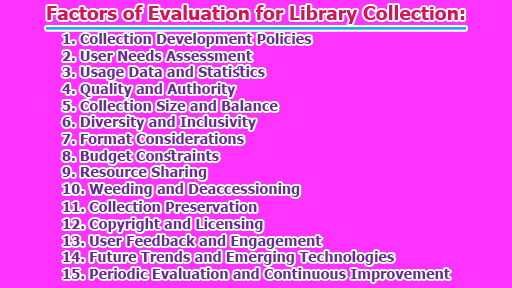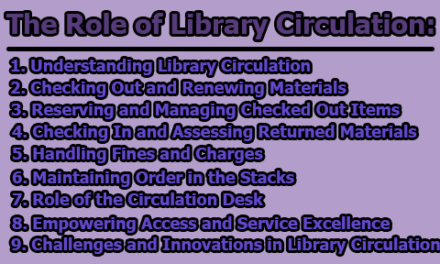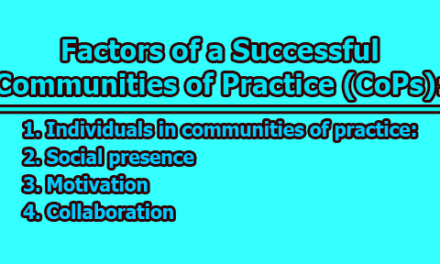Factors of Evaluation for Library Collection:
A library’s collection evaluation is a systematic process aimed at assessing the adequacy, relevance, and overall quality of the materials housed within the library. It serves as the foundation for curating a diverse and balanced collection that caters to the unique needs of its user community. Evaluating the library collection involves a multifaceted approach that considers various factors to ensure the collection is current, accurate, comprehensive, and meets the goals of the institution. There are several factors to consider when evaluating a library collection. Here are some key factors of evaluation for library collection to keep in mind:
1. Collection Development Policies: A collection development policy serves as the blueprint for building and maintaining a library’s collection. It outlines the library’s mission, goals, and objectives, and provides clear guidelines for the acquisition, weeding, and evaluation of materials. The policy should be a collaborative effort involving librarians, faculty, administrators, and library patrons to ensure it aligns with the needs of the user community and supports the institution’s educational and research objectives. The policy should be periodically reviewed and updated to remain relevant and adaptable to changing user needs and institutional goals.
2. User Needs Assessment: Understanding the information needs and preferences of library patrons is fundamental to developing a relevant and user-centered collection. User needs assessment can be conducted through various methods, such as surveys, focus groups, one-on-one interviews, and observation of user behavior within the library. These assessments provide valuable insights into the subjects, formats, and types of resources that users seek most, allowing librarians to prioritize acquisitions that cater to the specific interests and academic pursuits of the community.
3. Usage Data and Statistics: Quantitative data, such as circulation rates, database usage, and interlibrary loan requests, offers essential insights into the popularity and relevance of the library’s collection. This data helps librarians identify high-demand materials and gauge the overall effectiveness of the collection. Analyzing usage data also aids in identifying underutilized resources that may require promotion or reevaluation for potential weeding.
4. Quality and Authority: Maintaining the credibility of the library collection requires an evaluation of the quality and authority of information sources. Librarians must apply rigorous criteria when selecting materials, such as assessing author credentials, publisher reputation, peer-reviewed status, and citation frequency. These factors help determine the reliability and academic value of the resources, ensuring that users have access to accurate and trustworthy information.
5. Collection Size and Balance: A well-balanced collection reflects the diverse interests and needs of the user community while avoiding information overload or resource scarcity. Librarians should consider the size of the collection in relation to the user population, institutional goals, and available resources. Striving for balance across various subjects, formats, and difficulty levels ensures comprehensive coverage and supports multidisciplinary research and learning.
6. Diversity and Inclusivity: Promoting diversity and inclusivity in the library collection is vital to create an equitable and welcoming learning environment. Librarians should actively seek materials that represent diverse perspectives, languages, and cultures, reflecting the richness of the global community. This approach fosters an inclusive atmosphere that encourages learning, understanding, and respect among library users.
7. Format Considerations: As technology continues to advance, libraries must evaluate the appropriateness of different formats to meet user preferences and information consumption habits. While physical books remain relevant, digital resources, such as e-books, audiobooks, and multimedia materials, are gaining popularity. Librarians should ensure that the collection includes a mix of formats to cater to various learning styles and accessibility needs.
8. Budget Constraints: Collection development is often limited by budget constraints, making resource allocation a critical consideration. Librarians should prioritize acquisitions based on user needs, the relevance of materials to the curriculum, and the institution’s strategic priorities. Collaborating with faculty and other stakeholders can help ensure that budget decisions align with academic and research goals.
9. Resource Sharing: Collaborating with other libraries and consortia can significantly enhance the scope and depth of the collection without incurring excessive costs. Interlibrary loan programs and resource-sharing agreements enable libraries to access materials that may not be available in their own collections, broadening the resources available to users.
10. Weeding and Deaccessioning: Regular weeding and deaccessioning are essential for maintaining a current and relevant collection. Weeding involves the removal of outdated, damaged, or inaccurate materials, while deaccessioning refers to the permanent removal of items from the collection. Ethical guidelines, such as the CREW method (Continuous Review, Evaluation, and Weeding), ensure that weeding and deaccessioning are carried out responsibly and transparently.
11. Collection Preservation: Preserving valuable and rare materials is crucial for maintaining the historical and cultural significance of the collection. Librarians should implement proper conservation and preservation efforts, especially for fragile and unique items, to ensure their accessibility to future generations. Additionally, digitization projects can increase the accessibility and longevity of important resources.
12. Copyright and Licensing: With the rise of digital resources, adhering to copyright laws and licensing agreements is essential for legal access and usage. Librarians must be knowledgeable about copyright regulations and ensure that the library’s digital collection complies with copyright restrictions and licensing terms.
13. User Feedback and Engagement: Engaging with library patrons through user feedback mechanisms, such as suggestion boxes, surveys, and interactive sessions, allows librarians to understand user needs and preferences. User feedback helps identify gaps in the collection and areas for improvement. By involving the user community in the collection development process, libraries can ensure that their resources align with the changing needs of their users.
14. Future Trends and Emerging Technologies: Staying ahead of future trends and emerging technologies is critical for proactive collection development. Librarians should keep abreast of advancements in research methodologies, educational practices, and information dissemination to anticipate the evolving needs of the user community. This foresight enables libraries to prepare for upcoming demands and allocate resources strategically.
15. Periodic Evaluation and Continuous Improvement: Collection evaluation is an ongoing process that requires periodic review and continuous improvement. Librarians should regularly assess the collection’s strengths and weaknesses, seeking feedback from users and staying informed about developments in their respective fields. Periodic evaluation ensures that the collection remains current, relevant, and aligned with the institution’s mission and goals.
Finally, we can say that the evaluation of a library collection is an ongoing and collaborative effort that requires librarians to be attentive to user needs, responsive to emerging trends, and committed to maintaining a diverse, relevant, and high-quality collection. By continuously refining their collection, libraries can uphold their role as essential knowledge hubs in the digital age, serving as trusted resources for information dissemination, research, and learning.
FAQs:
What is the purpose of evaluating a library collection?
The purpose of evaluating a library collection is to ensure that it remains relevant, comprehensive, and aligned with the needs and preferences of its user community. Evaluation helps librarians make informed decisions about resource allocation, acquisitions, and weeding to create a dynamic and user-centered collection.
What are the key factors considered during the evaluation process?
The key factors considered during the evaluation process include user needs assessment, usage data and statistics, quality and authority of materials, collection size and balance, diversity and inclusivity, format considerations, budget constraints, resource sharing opportunities, and future trends and emerging technologies.
How do librarians assess user needs for the collection?
Librarians assess user needs through various methods, including surveys, focus groups, one-on-one interviews, and observing user behavior within the library. These assessments provide insights into the subjects, formats, and types of resources that users seek most.
What role does usage data and statistics play in collection evaluation?
Usage data and statistics, such as circulation rates, database usage, and interlibrary loan requests, offer valuable insights into the popularity and relevance of the library’s collection. Analyzing this data helps librarians identify high-demand materials and assess the overall effectiveness of the collection.
How do librarians ensure the quality and authority of information sources in the collection?
Librarians ensure the quality and authority of information sources by applying rigorous criteria, such as assessing author credentials, publisher reputation, peer-reviewed status, and citation frequency. These factors help determine the reliability and academic value of the resources.
Why is collection size and balance important?
A well-balanced collection reflects the diverse interests and needs of the user community while avoiding information overload or resource scarcity. Striving for balance across various subjects, formats, and difficulty levels ensures comprehensive coverage and supports multidisciplinary research and learning.
How does diversity and inclusivity play a role in collection evaluation?
Promoting diversity and inclusivity in the collection is crucial for creating an equitable and welcoming learning environment. Librarians actively seek materials that represent diverse perspectives, languages, and cultures, fostering an inclusive atmosphere that encourages learning, understanding, and respect among library users.
How do budget constraints impact collection evaluation?
Budget constraints influence resource allocation decisions, requiring librarians to prioritize acquisitions based on user needs, relevance to the curriculum, and institutional goals. Collaboration with other libraries and consortia can also help expand the collection without exceeding budget limits.
What is the role of weeding and deaccessioning in collection evaluation?
Weeding and deaccessioning are essential for maintaining a current and relevant collection. Weeding involves the removal of outdated, damaged, or rarely used materials, while deaccessioning refers to the permanent removal of items from the collection. Responsible weeding ensures that the collection remains streamlined and up-to-date.
How do librarians prepare for future trends and emerging technologies in collection development?
Librarians stay ahead of future trends and emerging technologies by monitoring developments in research methodologies, educational practices, and information dissemination. Anticipating the evolving needs of the user community allows libraries to allocate resources strategically and remain relevant in a rapidly changing information landscape.
References:
- Johnson, P. (2010). Fundamentals of Collection Development and Management. American Library Association.
- Saponaro, M. (2016). Collection Management Basics. American Library Association.
- Rubin, R. E. (2010). Foundations of Library and Information Science. Neal-Schuman Publishers.
- Evans, G. E., & Saponaro, M. Z. (2005). Developing library and information center collections. Libraries Unlimited.
- Dahl, C., & Behrens, S. J. (2019). Collection management in academic libraries: Perspectives and practices for the digital age. American Library Association.
- Johnson, P. (2009). Developing and Managing Electronic Collections: The Essentials. American Library Association.
- Drabenstott, K. M., & Mastel, K. E. (Eds.). (2011). Building and Managing E-Book Collections: A How-To-Do-It Manual for Librarians. Neal-Schuman Publishers.
- Shepherd, G., & Yule, P. (2018). Developing the new academic library: A review of the literature. Journal of Documentation, 74(1), 2-31.
- De Groote, S. L. (2011). Electronic resources: Selection and bibliographic control. In Encyclopedia of Library and Information Sciences (3rd ed., pp. 1745-1755). Taylor & Francis.

Library Lecturer at Nurul Amin Degree College










